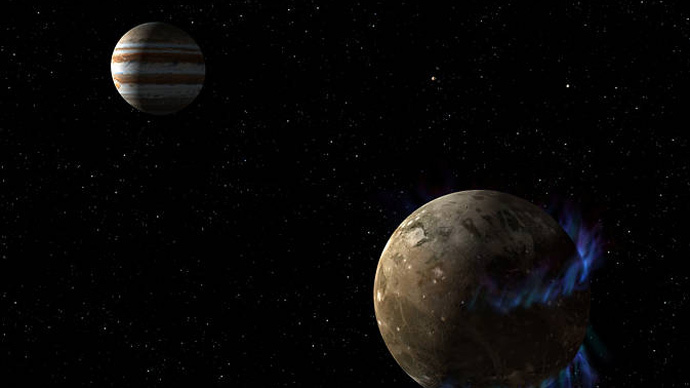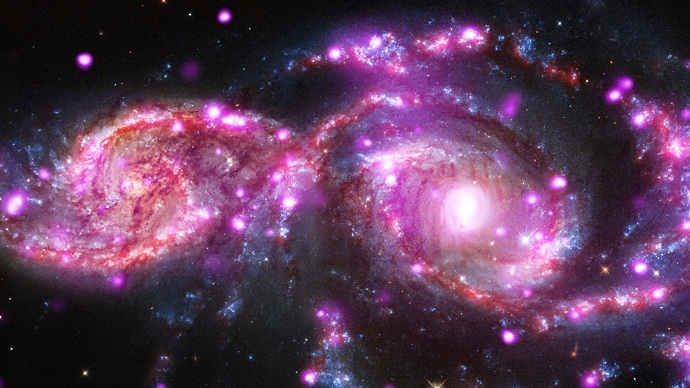Home » Posts tagged with "Hubble Space Telescope"
Universe expanding slower than thought
In this image, captured by the Gemini Observatory, shows at least three recent supernovas exploding on camera for the first time on May 21, 2008. It is suspected that these interactions sparked the formation of massive stars and the resulting fury of supernovae activity in this galaxy.
The universe may not be expanding since the Big Bang as fast as it was previously thought, astronomers say.
The discovery...
Jupiter moon Ganymede could have ocean with more water than Earth
In this artist’s concept, the moon Ganymede orbits the giant planet Jupiter.
New data suggests Jupiter’s moon Ganymede, the largest in the solar system, has an underground ocean which contains more water than all of Earth’s surface water combined, according to NASA.
NASA scientists were able to use the Hubble Space Telescope to collect more than seven hours of data about the auroral belts...
NASA's iconic 'Pillars of Creation' image gets amazing hi-res makeover
Twenty years after NASA’s iconic ‘Pillars of Creation’ image captured a series of gaseous columns stretching an astonishing five light years high, the space agency has recaptured the same scene and rendered it in high-definition.
Originally taken in 1995 by the Hubble Space Telescope, the Pillars of Creation image depicts the massive gas clouds spreading across a small region of the...
Galaxies spiral into each other, create spectacular light show
A new composite image of NGC 2207 and IC 2163 contains X-rays from Chandra X-Ray Observatory.
Two colliding galaxies in the Canis Major constellation put on an impressive light display that was captured in a composite image using data from NASA’s Chandra X-ray Observatory.
The galaxies, named NGC 2207 and IC 2163, were “caught in a grazing encounter,” NASA said in a statement. The two have hosted...
NASA finds 'monster' black hole in tiny galaxy
The M60-UCD1, discovered by NASA’s Hubble Space Telescope in 2013, is one of the smallest known galaxies. But now the space agency has discovered that the dwarf galaxy is harboring a “monster” black hole.
The diameter of M60-UCD1 is about 300 light years – just 1/500th of our galaxy’s width. However, it is packed with 140 million stars, which also makes it one of the densest galaxies.
For...
Hubble records Asteroid break-up into 10 pieces
This series of Hubble Space Telescope images reveals the breakup of an asteroid over a period of several months starting in late 2013. The largest fragments are up to 180 meters (200 yards) in radius.
The National Aeronautics and Space Administration (NASA)’s Hubble Space Telescope has recorded the never-before-seen break-up of an asteroid into as many as 10 smaller pieces.
Fragile comets, comprised...
Metoer shower to illuminate dark night sky
The annual Quadrantid meteor shower of 2013 is to reach its peak at the night sky of the early morning on Thursday, January 3, only for few hours.
According to NASA scientists, skywatchers can expect to see the display of 60 to 200 meteors an hour streak across the dark sky after the moon sets.
“Those who brave the cold might see up to 40 meteors per hour, although moonlight will make faint...
Brightest supernova in 40 years appears
Berkeley scientists this week discovered a new supernova, closer to Earth than any seen in the last 40 years, and believe they’ve spotted it within hours of its explosion.
Astronomers are now scrambling to observe it with as many telescopes as possible, including the Hubble Space Telescope, and it’s likely to remain a major target for research for the next decade or more.
Dubbed PTF 11kly,...
Mysterious Glowing Spiral Sighted in a Remote Star System
None of the world’s experts no what the strange spiral structure on the left is. Why the spiral glows is itself a mystery, with a leading hypothesis being illumination by light reflected from nearby stars.
NASA astronomers think it is related to a star in a binary star system entering the planetary nebula phase, when its outer atmosphere is ejected.
The huge spiral spans about a third of a light...
The Universe Will Never Cease to Amaze Us
Click to enlarge
This photo shows the Antenna galaxies, which started colliding 100 million years ago, creating millions of stars in the process which later exploded as supernovas. I really find it hard and sad to know that I’ll never see this live.
But at least we have the telescopes to see it from here. The image of the galaxy—which is located 62 million light-years away from Earth—was...




















